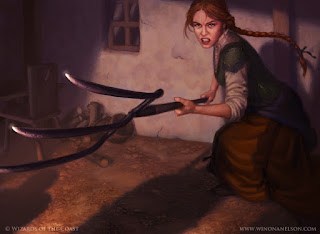The three save model was popularized by corporate Dungeons and Dragons, and works pretty well by simplifiying saves and therefore speeds things up. I think so, anyway.
Instead of a bunch of sort of random yet arbitrary saving throws with arbitrary values based on… what? I don’t know. My Four Save Model goes like this…
I’ve never played 3/3.5 DnD, so I don’t know how saves work in that game. I’ve played 4th, which honestly is the inspiration for this. Don’t judge me too quickly! 4th was a fun fantasy tactical game, but was marketed incorrectly.
Willpower – Anything that requires a save like resisting delicious ice cream, trying to ignore terrible sounds like Alanis Moressette songs, working through a fear of darkness without a night light, etc
Fortitude – eating a three day old, room temperature Taco Bell Taco Supreme (yes, with sour cream) without getting food poisoning, beer bonging a handle of cheap vodka without puking, seeing your grandparents having sex, etc
Agility – dodging out of the way of a thrown wrench, dodging fireballs shooting up from the floor as you cross a bridge only to discover your princess is in another castle, running and leaping away from the big climactic explosion even though you’re getting too old for this shit, etc
Magic – Pretty much anything not covered by the other three saves.
These are roll-over values on a d20. In layman’s terms: roll a d20 and get a high number.
The value you must roll above is not arbitrarily chosen by some unpaid game designer with a chip on their shoulder. Instead, it is determined by YOU, the player! Cool, huh?
Willpower is your character’s Wisdom modifier + Charisma modifier, subtracted from 17.
Fortitude is your character’s Strength modifier + Constitution modifier, subtracted from 17.
Agility is (you guessed it) your character’s Intelligence modifier + Dexterity modifier, subtracted from 17.
Magic is your character’s Intelligence modifier + Wisdom modifier, subtracted from 17.
So, there is an arbitrary bit in there; why 17, and not 20? Because some characters will have no modifiers, and they’ll have to save by rolling over 20.
If you have a negative modifier, like from having a really terrible attribute, that modifier is added to 17. So it IS possible to have to roll a 20 (or higher) for a save.
So at first level, you’ll have a save range of 12-18. Since your modifiers have already been used to determine this value, they are not added to subsequent saving throw rolls. Sorry.
This model is used the same for all classes. So your clericky character should have a decent Willpower, your Fighter-type should have a decent Fortitude, and your Wizardy or Thieving types will have decent Agility.
Other bonuses apply to your roll; like if your character has a +3 vs Poison for whatever reason, then you would add +3 to your Fortitude rolls when dealing with poisons. If your character has a +1 to balance because they have a background as a child acrobat, then you add +1 to Agility rolls when you’re trying to walk on a tight rope.
Easy peasy.
Example:
Tim the first level Fast Talking Specialist has the following attributes:
Charisma:15 (+2 mod)
Constitution: 5 (-2 mod)
Dexterity: 17 (+3 mod)
Intelligence: 9
Strength: 11
Wisdom: 11
So, his Saves are as follows:
Agility: 17-3 = 14
Fortitude: 17 – (0-2) = 19
Willpower: 17 – 2 = 15
Magic: 17 -0 = 17
Yeah, that’s a really shitty Fortitude.
Fortunately, saves can improve! Each class will have an experience progression table which will include improving saving throws.
I haven’t play tested this yet; it is in the thinking about stage right now.







